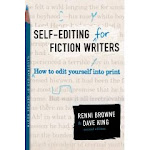First Pass – I make certain that each scene (if there’s more than one per chapter) has strong conflict and is necessary to move the story along. I’m ruthless here—good writing alone NEVER justifies a scene’s inclusion in the finished product.
Second Pass – I check my timeline and the sequence of events. I make sure everything is logical. For example, I look to see if I have a character giving a response before an event happens.
- Elisa jumped when a loud pop echoed in the chamber.
- The loud pop echoed through the chamber and Elisa jumped, knocking her head against the back of the chair.
The second example puts things more logically.
During this pass I also check to see if I have a balance of speaker beats and speaker tags.
Third Pass – I check for passive writing. I do a search for the word was and study each usage to make certain it’s past tense—not passive tense.
- Stuart was walking across the yard.
- Stuart walked (or better yet, strolled) across the yard.
In the second example the verb is much stronger.
Fourth Pass – I look for telling, instead of showing. These are some clue words I search for:
- Felt
- Remembered
- Knew
- Watched
- Saw
- Looked
- Was
- -ing words
- -ly words
Fifth Pass – I look for times when I’ve named emotions instead of showing them.
- Bethany felt panic course through her system. Had she waited too long?
- Bethany could feel her nails cutting into her palms as she fisted her hands. Had she waited too long?
Sixth Pass – I look to see if each scene contains all five senses.
Here are two senses I had to add to the scenes I was working on.
- Substandard lighting and circulation led to the lingering odor of sulfur mixed with leaching compounds. At almost two clicks beneath the metropolis the noxious haze, unable to dissipate, lingered to burn the throat of any unfortunate worker.
- Dawn had broken, but instead of beauty, a dank haze hung over the city. He could still taste the metallic bite in the polluted air.
This is the process I always use. It won’t catch everything, but it gets me a long way down the road. After going through these seven steps I set the chapter aside and move on to the next one. This gives me my second draft.
There are many good books out there on this subject, especially Self-Editing for Fiction Writers by our own Dave King. All I’ve done is break the process down into one I could replicate with any manuscript. What are some tricks you use when you’re in the editing process?













